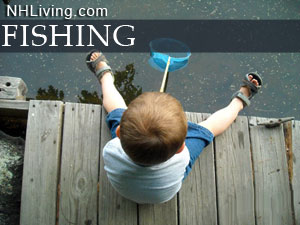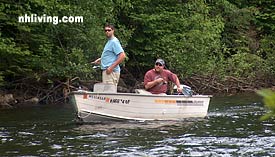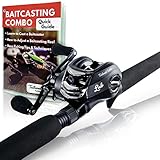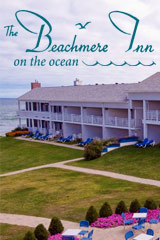Trolling for NH Lake Trout & Salmon
Freshwater Fishing For Landlocked Salmon & Lake Trout
 Fishing in New Hampshire is a favorite way to pass the time. With all the lakes and beautiful scenery, it is no wonder. If you are interested in catching big fish – consider trolling for lunker Lake Trout and silvery Landlocked Salmon in the deep waters of the Connecticut Lakes in Pittsburg, or Lake Winnipesaukee in the NH Lakes Region. Ask us about NH trolling or share fishing comments. Feature your business, contact us.
Fishing in New Hampshire is a favorite way to pass the time. With all the lakes and beautiful scenery, it is no wonder. If you are interested in catching big fish – consider trolling for lunker Lake Trout and silvery Landlocked Salmon in the deep waters of the Connecticut Lakes in Pittsburg, or Lake Winnipesaukee in the NH Lakes Region. Ask us about NH trolling or share fishing comments. Feature your business, contact us.
NH Lake Trout and Salmon Fishing

Partridge Cabins, 3 Partridge Road, US Route 3, Pittsburg, NH 03592 | Ph: 603-538-6380
Visit Partridge Cabins and Lodge - the four season place to be. We have 600 feet of lake frontage, and offer housekeeping cabins situated amidst the shade of sheltering spruce and fir trees. Completely winterized cabins with gas heaters, private baths, with hot and cold running water, electricity, and full kitchen facilities. All cabins are attractively furnished, and accommodate 4-8 people. Snowmobile, cross-country ski, hike, moose watch, and let's not forget fishing and hunting! Summer, fall, winter, and spring, you will find Partridge Lodge & Cabins most pleasing.
Visit Partridge Cabins - Pittsburg, NH

Twin Mountain Campground, 100 US Route 302 East, Twin Mountain, NH 03595 | 603-846-5513
If you like the feeling of clean, quiet, and secure, then you will enjoy our pleasant, wooded setting surrounded by the panoramic beauty of New Hampshire's White Mountains. The Ammonoosuc River borders the campground providing trout fishing and scenic beauty for our campers. Facilities include RV and Trailer Sites (full Hook up), Custom Built Log Cabins, Restrooms, Playground, Tent Sites, Inground Pool, and more. Experience the difference at New Hampshire's most unique campground. Formerly Living Water Campground.
Visit Twin Mountain Campground - Twin Mountain, NH

Inn at Ellis River House B&B Inn, 17 Harriman Road, Jackson, NH 03846 | 603-383-9339
Enchanting Country Inn offering "Romance & Rejuvenation" on the river in the heart of the White Mountains. 20 rooms and cottage are beautifully appointed with period and modern amenities. Many have Jacuzzis for two and/or balconies, most have fireplaces. Gourmet country breakfast and afternoon refreshments included. Enjoy the cozy game room/pub, hot tub, sauna, and outdoor heated pool. Relax, re-discover lifes simple pleasures, hike, fish, golf nearby, cross country or downhill ski, outlet shop and more. Let the Inn at Ellis River rejuvenate your spirits!
Visit Inn at Ellis River - Jackson. NH

Omni Mount Washington Resort, 310 Mt Washington Hotel Rd, Bretton Woods, NH, 03575
Spectacular views. On premises dining. The on-site spa has 13 treatment rooms and offers deep-tissue massages, hot stone massages, prenatal massages, and sports massages. Types of treatments available include aromatherapy, Ayurvedic treatments, body scrubs, and body wraps. Check current availabilities and special rates below.
Visit Omni Mt Washington Resort - Bretton Woods, NH
 Trailing a line from a slowly moving boat (known as trolling) is a very popular and relaxing way to enjoy the outdoors and offers an exciting way to land a fish, especially if using fly rods. The slow-paced atmosphere of making passes over your favorite fishing hole, coupled with the fast-paced mayhem of pulling in extra lines when a fish is hooked, makes for a great fishing adventure.
Trailing a line from a slowly moving boat (known as trolling) is a very popular and relaxing way to enjoy the outdoors and offers an exciting way to land a fish, especially if using fly rods. The slow-paced atmosphere of making passes over your favorite fishing hole, coupled with the fast-paced mayhem of pulling in extra lines when a fish is hooked, makes for a great fishing adventure.
Before setting out, read all the local and state laws pertaining to salmon fishing. Choosing a lake can be a challenge because of all the great locations New Hampshire has to offer. Typically there are a few key things to keep in mind when choosing a location. Salmon often reside in colder, large, deep lakes. Smaller bodies of water typically won’t yield a good salmon catch, and trolling over the same area may induce boredom. Large bodies of water offer much easier trolling passes and lessen the risk of tangled lines caused by frequent and sharp turns. If choosing an unfamiliar lake, bring a map and become acquainted with the shape, depth, and of your starting location before heading out. Try to reference landmarks such as unique landforms or structures to keep your bearings.
Dress for the occasion! Becoming cold or wet can cut any fishing trip short, making extra layers of clothing and proper apparel very important. Keep in mind that the ice has recently lifted from the waterways, and when the wind picks up it will take with it the chill of the frigid water. Often times setting out early will allow for a few hours of fishing on what seems to be a sheet of glass, but shortly after sunrise, the wind usually rises as well. Waterproof apparel is a plus, especially when spraying from choppy waters and higher winds come into play. It is a good idea to pack a cooler because trolling can easily become an all-day adventure, especially when the fish are biting.
Before hitting the open waters, make sure you have the right tackle. The most effective trolling rods are lightweight fly rods, equipped with sinking lines and about 15 to 20 feet of monofilament on the tip, dressed with a streamer. A streamer is a type of fly lure used to imitate a smelt. Smelt is a small fish that can also be baited and used to troll for salmon. Spin cast rods can be substituted and used in conjunction with smelts or smelt imitating lures, but are not as exciting to catch a fish on. Rod holders are a must! Holding the rod while trolling becomes unimportant as it is best to watch the action of the rod, and listen for the distinct sound of a reel being stripped of the line when a fish hits. Trolling is a slow, finesse sport meaning a big motor is not needed. The ideal motor would be small, quiet, and environmentally friendly. This will cause fewer vibrations and makes holding a conversation a lot easier. It is a good idea to have a larger motor for general transportation, in conjunction with a trolling motor for when you reach your fishing destination. Bringing extra fuel or a spare battery and paddles is good boating practice as well.
Once you have taken to the water and are ready to begin trolling, first make sure the rod holders are firmly in place and spaced out enough so tangles won’t become an issue. As many as 4 lines can be used when trolling (2 in the back, 1 left and right) without having to worry too much about tangles. Be conscious of the direction the boat is headed in, and make turns large and deliberate.  Before letting the line out, make sure the lure is swimming properly. If a streamer spins, it will cause the monofilament to twist and become tangled when you reel up, and will also weaken the line. Let about 50-60 feet of line out in the back of the boat, keeping the lines to their respective sides. It is easiest to mark the lines with paint prior to heading out so you know when to stop letting the line out. This will place your choice lure about 3 feet under the surface of the water. Make sure the drag is set so you will hear the reel tick if something strikes the line. Once all the lines are out, sit back and relax, and make long sweeping passes down the waterway. Be careful of shallow waterways which might have weeds and debris. Salmon tend to stick to the deeper sections of the lake.
Before letting the line out, make sure the lure is swimming properly. If a streamer spins, it will cause the monofilament to twist and become tangled when you reel up, and will also weaken the line. Let about 50-60 feet of line out in the back of the boat, keeping the lines to their respective sides. It is easiest to mark the lines with paint prior to heading out so you know when to stop letting the line out. This will place your choice lure about 3 feet under the surface of the water. Make sure the drag is set so you will hear the reel tick if something strikes the line. Once all the lines are out, sit back and relax, and make long sweeping passes down the waterway. Be careful of shallow waterways which might have weeds and debris. Salmon tend to stick to the deeper sections of the lake.
When a fish bites, stop the boat, have everyone reel in the extra lines, and keep your rod tip high. Salmon are known for jumping, so try and keep the line tight. The best method of pulling in a fish with a fly rod is to use a hand-over-hand method. The hand on the rod holds the line and controls the drag, and the other hand is used to pull loops of line in and coil them near your feet. Be careful not to tangle or step on the line, and be sure to give the fish extra line if it decides to run. When the fish is ready to be landed, try hard to keep it from striking the boat. The use of a net (long handle and large scoop) makes it easier to avoid breaking the monofilament and losing the fish and lure. It’s good to have a ruler and fishing scale handy to make sure the catch is within regulation, and to help with future fishing tales. After the thrill of landing a fish, or even after losing one, check your tackle, get reorganized and reoriented, and start out again.
Typically the phrase “early bird gets the worm” comes into play when fishing for salmon. The best hours to tease a salmon with a line are early in the morning. Don’t be discouraged and turn back early if you’re not lucky immediately because the fish will bite throughout the day. It is a good habit to use a variety of bait and tackle. Pay attention to the fish. Try something else if the fish aren’t biting, and continue using what you can’t keep in the water. Streamers ranging from black and white to pink and blue work great so don’t be afraid to mix it up. Some of the more popular salmon streamers are called a “Moose River” or a “Grey Ghost”. For fishing information and tips please visit our Fishing Tips page.
~ Erik T. for nhliving.com
<p style=”text-align: left;”>
- Dr.fish complete fishing kit includes 1 fishing rod, 1 spinning reel, 1 fishing tackle bag, 1 spool of 550Yard fishing line, 2 sets of spinners and hardbaits in lure boxes, 2 packs of softplastic worm, 1 fishing scissors,1 fishing pliers and a set of rigging accessories.
- PORTABLE TELESCOPIC FISHING ROD: High modulus Carbon fiber combine fiberglass blank, stainless steel guides frame with ceramic ring, and Aluminum reel seat assure great functionality and durability. 6ft, fast action, medium power, 1/6-1oz lure weight.
- ULTIMATE SMOOTH SPINNING REEL: Corrosion-resistance construction, Aluminum Spool, Stainless Steel Shaft and 9+1 High Power ball bearings all contribute to this efficient spinning reel. Size 3000, Ratio 4.9:1, Capacity 8Lb/220Yd, Max Drag 14Lb. Handle any freshwater and saltwater fish without hassle.
- MULTI-PURPOSE FISHING TACKLES BAG: Water-resistant 900D oxford fabric can be used as waist pack, shoulder bag or carry bag. All fishing gear, except for rods, can be stowed in this bag. Outer Dimension: 11.8*7.9*7.1 inches. Great for men, women and teen.
- CATCHING- GUARANTEED LURES AND RIGS: All lures are the hottest models on the market, mainly target bass, trout and perch. Rigging kit and soft lures would provide dropshotting, Texas rig and any other productive rigs. Pliers would make all hassle easier to deal with.
- COLLAPSIBLE FISHING POLE - This 6.6-foot-long durable fiberglass fishing pole will cast longer distances while providing adequate hook-setting power for bass, trout, and even pan fish, and is sure to make fishing enjoyable from the shoreline or in a boat.
- SPINNING ROD - The 5.2:1 ratio 3000 series open-style aluminum spinning reel, known for its easy operability, allows you to feel cool and confident when the fish start to bite. The reel is pre-spooled with 215-yards of 10lb test monofilament fishing line.
- NON-SLIP HANDLE - The EVA foam handle on this rod and reel combo provides a secure grip while reeling in your catch and the non-slip foam knob offers a safe and comfortable grasp on the pole while cushioning your hands during a long day on the water.
- PORTABLE - Perfect for ponds, lakes, and shoreline angling, this fishing pole and reel combo has everything you need for catching bass, salmon, sunfish, trout, and more, and the pole separates for compact storage and travel to your next outdoor adventure.
- PRODUCT DETAILS - Materials: Fiberglass, Aluminum, and EVA Foam. Dimensions: Rod: (L) 78". Gear Ratio: 5.2:1. Includes Fishing Rod and 3000 Ambidextrous Reel Pre-Spooled with 215-yards of 10lb Monofilament Line and 2 Ball Bearings. Color: Blue and Black.
- EASY-TO-USE: The Zebco 33 spincast combo features a 6-foot 2-piece fishing pole and size 30 fishing reel. You will be ready to hit the water with the patented no-tangle design reel that comes pre-spooled with 10-pound Zebco Cajun line. Whether you’re curious or serious about fishing, the reel that taught America to fish makes it easy
- EXPERTLY DESIGNED: The 33 combo combines classic design and modern performance to make every fishing experience a memorable one. The easy-to-use fishing combo is custom-matched to a sturdy fiberglass rod to help you to reel in the big ones all day long
- ALL-DAY COMFORT: This hard-working fishing reel and rod combo comes with a EVA rod handle to provide anglers with hours of comfort. Its moderate-fast action and medium power is ideal for targeting a wide variety of species from panfish, trout, bass, catfish and more and is designed to hold a 6-14-pound line weight and 1/8-3/4 oz lure weights
- SMOOTH PERFORMANCE: This spincast reel is constructed with all-metal gears and a 3.6:1 gear ratio for a silky-smooth retrieve. The changeable right- or left-hand retrieve reel features a MicroFine dial-adjustable drag and QuickSet anti-reverse to stop your handle from moving backward and create a solid hookset in the mouth of a fish when reeling in your catch
- 4-PIECE KIT: This fishing kit includes a rod, reel, line, leader, and fly fishing accessories like a rod/reel case
- READY-TO-FISH: This fly fishing kit includes the Encounter 8'6" 5-wt. rod, a size II Encounter reel, 5-wt. line, backing, 4X leader, and rod/reel case
- 5-YEAR GUARANTEE: Covered by Orvis's 5-Year, no-questions-asked guarantee
- ENCOUNTER REEL: Fishing rod includes size II Encounter reel for all you need to start fishing today
- PERFORMANCE & AFFORDABILITY: This fishing rod and reel kit has all the power and performance needed priced with frugality in mind for the ideal starter kit
- CLEARWATER LARGE ARBOR size II for 4-6-Weight fly fishing line, 5.4 oz., 3½-inch diameter; and size IV for 7-9-Weight fly fishing line, 6.1 oz., 3¾-inch diameter.
- SMOOTH-AS-SILK PERFORMANCE at an incredible value, delivering the best performance-to-value in the industry.
- DIE-CAST FLY REELS with stealthy matte-gray powder-coat finish deliver performance comparable to more expensive machined fishing reels.
- CARBON-TO-STAINLESS STACKED DISC DRAG with positive click drag knob delivers consistent settings every time.
- EASY CONVERSION between left- and right-handed fly line retrieve.
- ORVIS IS DEDICATED to making high-quality fly fishing accessories for your outdoor adventures, and the Clearwater Large Arbor Reel (2S53) features the best performance-value ratio in the industry.
- COMMON SEARCH TERMS: fly fishing rod and reel combo, fly rod, fly fishing rod, fly rod and reel combo, fly reel, fly fishing reel, telescoping fishing rods, ultralight fishing rod, fishing rod & reel combos, fly fishing reels, fly reels, centerpin reel, fly fishing accessories, fly fishing rod and reel, fishing tools, fly fishing gear, fishing rod and reel, carretes de pesca, carrete de pesca, fly fishing reels, carretes de pesca agua salada, fly reels.
- UGLY STIK 6’6” ELITE FISHING ROD AND REEL CASTING COMBO: Featuring 35% more graphite than the Ugly Stik GX2 for a lightweight yet legendarily tough, ready-for-anything rod. Right handle position.
- UGLY TECH CONSTRUCTION: 1-piece, Ugly Tech construction combines graphite and fiberglass, for a strong, yet sensitive rod with fast action. Includes 7 year warranty on rod. of 6.2:1 provides smooth operation and mechanical advantage.
- SIZE LP EXPOSED BLANK REEL: 3 ball bearing system for smooth operation. Features 8 UglyTuff guides to provide durability and eliminate insert pop-outs during rough treatment. Adjustable magnetic cast control.
- STAR DRAG: Max drag: 12lb | 5.4kg. Durable machined aluminum ported spool; Instant Anti-Reverse system helps keep fighting the fish on your terms. Cork over a lightweight graphite composite frame with double paddle aluminum handle.
- 10-20LB LINE RATING, MEDIUM HEAVY POWER: Ugly Stik Clear Tip delivers strength and sensitivity. Mono Capacity yd/lb: 160/10 130/12 110/14 (m/mm: 145/0.29 120/0.32 100/0.35).
- Fishing kit INCLUDES 1 FISHING ROD + 1 FISHING REEL + VARIOUS FISHING LURES + FISHING HOOKS + FISHING LINE + FISHING BAG CASE + SOME NESSARY ACCESSORIES
- Full kit is special made for novice, including nessary accessories for fishing. You can use it without buying any other accessories from anywhere. Perfect elasticity, high density Carbon fiber mixed with fiberglass make your fishing pole hard & durable.
- Perfect elasticity, high density Carbon fiber mixed with fiberglass make your fishing pole hard & durable. Stainless Steel Hooded Reel Seats is anti-seawater corrosion; EVA Fore Grip for comfort. The telescopic fishing rod is portable, and closed length design is convenient carrying around. Power: Medium; Extended Handle.
- Instant anti-reverse; Power drive gear equipped for high strength. Deep aluminium spool with double color and one line holes; More short body with large spool and large line capacity. Line capacity: mm/M 0.20/240 0.25/200 0.30/140. Model: HA3000; Gear ratio: 5.2:1.
- We love our customers and 12 months warranty provided. If any problem, please contact us firstly and our customer service will solve it for you soon. KINDLY NOTE: FISHING ROD HOLDER IS NOT INCLUDED. Want to buy fishing rod holder? Please search the ASIN: B0116X3MNQ or B016Y4594C
- UGLY STIK 6’6” ELITE FISHING ROD AND REEL SPINNING COMBO: Featuring 35% more graphite than the Ugly Stik GX2 for a lightweight yet legendarily tough, ready-for-anything rod. Right/Left handle position.
- UGLY TECH CONSTRUCTION: 2-piece, Ugly Tech construction combines graphite and fiberglass for a strong, yet sensitive rod with medium fast action. Includes 7 year warranty on rod. Gear ratio of 5.2:1 provides smooth operation and mechanical advantage.
- SIZE 30 EXPOSED BLANK REEL: 5 ball bearing system for smooth operation. Features 7 UglyTuff guides to provide durability and eliminate insert pop-outs during rough treatment.
- FRONT DRAG: Max drag: 10lb | 4.5kg. Durable machined aluminum spool with extra-durable oversized bail wire; Instant Anti-Reverse system helps keep fighting the fish on your terms. Cork over a strong, machined aluminum handle.
- 6-14LB LINE RATING, MEDIUM POWER: Ugly Stik Clear Tip delivers strength and sensitivity. Mono Capacity yd/lb: 190/4 140/6 110/8 (m/mm: 175/0.20 130/0.23 100/0.25).
New Hampshire Fishing
NH Fishing License Info | Spring Fishing | Drift Fishing
Fishing For Lake Trout & Salmon
NH Lodging Guide | Weddings
Products | NH Town Guides
Free World Mall
Country Weddings | New England Recipes
Paradise Coast Living | Boston Red Sox Gifts
Vermont Living | ME Living | MA Living
















